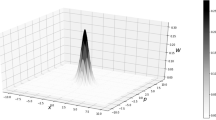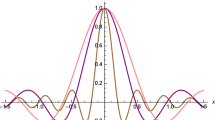Abstract
The generalized uncertainty principle (GUP) is a natural consequence of many proposed quantum gravity theories that indicate the modification of quantum mechanics and classical mechanics. A unified classical quantum framework also leads to the interpretation of a Wigner phase-space distribution of a state as a KvN wave function. In this article, we utilize the classical-quantum unified framework to calculate the expression for the GUP-modified Wigner function of a classical harmonic oscillator in the configuration space instead of the conventional approach that uses the momentum space. Further, we plot the modified Wigner functions and show that they are similar to the results obtained in the past literature.



Similar content being viewed by others
References
T W B Kibble Commun. Math. Phys. 65 189 (1979).
A Ashtekar, TA Schilling arxiv:9706069 [gr-qc] v1 23Jun (1997) https://doi.org/10.48550/arXiv.gr-qc/9706069
J Anandan and Y Aharonov Phys. Rev. Lett. 65 1697 (1990).
J Anandan Found. Phys. 21 1265 (1991).
A Heslot Phys. Rev. D 31 1341 (1985).
D J Rowe, A Ryman and G Rosensteel Phys. Rev. A 22 2362 (1980).
J E Marsden and T Ratiu Introduction to Mechanics and Symmetry, 2nd edn. (New York: Springer) (1999)
G Marmo and G F Volkert Phys. Scripta 82 038117 (2010).
J von Neumann Ann. Math. 33 587 (1932).
B O Koopman Proc. Natl. Acad. Sci. USA 17 315 (1931).
V I Arnold Mathematical Methods of Classical Mechanics, 2nd edn. (New York: Springer) (1989).
E Wigner Phys. Rev. 40 749 (1932).
D I Bondar, R Cabrera, D V Zhdanov and H A Rabitz Phys. Rev. A 88 052108 (2013).
A F Ali et al Phys. Rev. D 84 044013 (2011).
A Kempf, G Mangano and R B Mann Phys. Rev. D 52 1108 (1995).
S Das and E C Vagenas Phys. Rev. Lett. 101 221301 (2008).
P Pedram Int. J. Mod. Phys. D 19 2003 (2010).
L N Chang et al Phys. Rev. D 65 125028 (2002).
A F Ali et al Phys. Lett. B 678 497 (2009).
F Scardigli Phys. Lett. B 452 39 (1999).
F Scardigli and R Casadio Class. Quantum Gravity 20 3915 (2003).
F Scardigli and R Casadio Eur. Phys. J. C 75 425 (2015).
F Scardigli, M Blasone, G Luciano and R Casadio Eur. Phys. J. C 78 728 (2018).
S Hossenfelder Living Rev. Relativ. 16 2 (2013).
A N Tawfik and A M Diab Rep. Prog. Phys. 78 126001 (2015).
O I Chashchina, A Sen and Z K Silagadze Int. J. Mod. Phys. D 29 2050070 (2020).
E C G Sudarshan Pramana 6 117 (1976).
T N Sherry and E C G Sudarshan Phys. Rev. D 18 4580 (1978).
A Sen, S Dhasmana and Z K Silagadze Ann. Phys. 422 168302 (2020).
W B Case Am. J. Phys. 76 937 (2008).
D I Bondar, R Cabrera, R R Lompay, M Y Ivanov and H A Rabitz Phys. Rev. Lett. 109 190403 (2012).
E Gozzi, E Cattaruzza and C Pagani Path Integrals for Pedestrians (Singapore: World Scientific) (2016) https://doi.org/10.1142/9183
H S Snyder Phys. Rev. 71 38 (1947).
S Mignemi Phys. Rev. D 84 025021 (2011).
H Kragh Rev. Hist. Sci. 8 401 (1995).
G Wataghin Nature 142 393 (1938).
P Bosso Phys. Sci. Forum 2 35 (2021).
R Casadio and F Scardigli Phys. Lett. B 807 135558 (2020).
J Mostowski, J Pietraszewicz arXiv (2021) https://doi.org/10.48550/arXiv.2104.06638
S Das et al Can. J. Phys. 94 139 (2016).
F Bopp Ann. Inst. H. Poincaré 15 81 (1956).
Acknowledgements
We would like to thank Zurab K. Silagadze.
Author information
Authors and Affiliations
Contributions
BKP: Investigation, writing - original draft, writing—review & editing. AS: Conceptualization, supervision, writing—review & editing.
Corresponding author
Additional information
Publisher's Note
Springer Nature remains neutral with regard to jurisdictional claims in published maps and institutional affiliations.
Appendices
Appendix A Wavefunctions expression
The expression for the ground state, first excited state & second excited state of the wave function \(\Psi (q_{1},q_{2},t)\) are given as follows:
In the derivation of the preceding equations, we have approximated \(\beta\) to the first order. Furthermore, we have set \(n_{1} = n_{2}\) during the calculation of the ground and excited states to eliminate time dependence, as differing values of \(n_{1}\) and \(n_{2}\) would introduce such dependence.
Appendix B Expression of modified Wigner function \(W(q,\Pi )\)
In order to find the modified Wigner function \(W(q,\Pi )=\psi (q,\Pi ,t)\), we use the Eq. (34) and we perform transformations of the form \(u = q + Q/2\) & \(v = q - Q/2\) so that the function \(\Psi (q_{1},q_{2},t)\) transforms as \(\psi (q, Q, t)\). Now the Fourier transform of the calculated function \(\psi (q, Q, t)\) using the Eq. (41) gives the modified Wigner function \(W(q,\Pi )\) for the ground state, 1st & 2nd excited states as follows:
Appendix C Expression for probability distributions for harmonic oscillator with GUP
We define the classical probability density for unperturbed (\(\beta =0\)) HO as
where \(E^{(0)}_{n} = (n + 1/2) \hbar \omega \kappa\) & \(T_{cl}=\dfrac{2 \pi }{\omega }\) is the time period of the SHO. Similarly, for the modified HO (\(\beta \ne 0\)), solving the Hamiltonian Eq. (26) we obtain
Now the modified classical probability density (for \(\beta \ne 0\)) for the Hamiltonian Eq. (26) is
where the modified time period is given as [26] \(T_{cl-modified} = \dfrac{2 \pi }{\omega } \left( 1 - \dfrac{3 \alpha }{2} \xi _{0}^{2} \right)\) and \(E_{n} = (n + 1/2) \hbar \omega \kappa + \dfrac{\alpha }{4} (6 n^{2} + 6 n +2) \hbar \kappa \omega\).
The expression for the quantum probability distribution can be calculated by integrating the Wigner functions Eqs. (47), (48), (49) using the Eq. (42) and it can be expressed, for ground state, first excited state, and second excited state respectively as
Appendix D Expression for \(\xi _{0}\)-free modified Wigner function \(W(q,\Pi )\)
By employing the methodologies delineated in “Appendix 1” and utilizing Eqs. (34) and (35), it is feasible to compute the \(\xi _{0}\) parameter-free Wigner functions \(W(q,\Pi )\) for the ground state, first excited state, and second excited state. The Wigner function for the ground state, 1st excited state, and 2nd excited state are given by:
Notice that Wigner functions \(W(q,\Pi )\) for \(\alpha = 0\) is same as in the Ref. [39].
Rights and permissions
Springer Nature or its licensor (e.g. a society or other partner) holds exclusive rights to this article under a publishing agreement with the author(s) or other rightsholder(s); author self-archiving of the accepted manuscript version of this article is solely governed by the terms of such publishing agreement and applicable law.
About this article
Cite this article
Parida, B.K., Sen, A. GUP modified Wigner function using classical-quantum unified framework. Indian J Phys (2024). https://doi.org/10.1007/s12648-024-03086-7
Received:
Accepted:
Published:
DOI: https://doi.org/10.1007/s12648-024-03086-7




